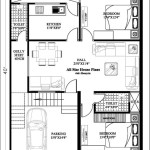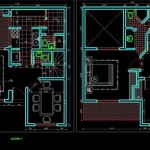Floor Plans For Small Houses With 4 Bedrooms: Maximizing Space and Functionality
Designing a small house with four bedrooms presents a significant architectural challenge. The objective is to create a comfortable and functional living space within limited square footage. Successfully achieving this requires careful consideration of space allocation, layout optimization, and the implementation of smart design strategies. This article will explore key considerations and effective floor plan approaches for small four-bedroom houses.
Prioritizing Needs and Defining Requirements
Before embarking on the design process, a thorough assessment of the homeowner's needs and priorities is crucial. This involves considering the number of occupants and their individual requirements. For instance, families with young children will have different needs compared to families with teenagers or multi-generational households. Understanding these specific requirements will inform the layout and allocation of space.
A detailed needs assessment should include the following considerations:
- Occupancy: The number of people who will be living in the house directly impacts the size and configuration of bedrooms and common areas.
- Lifestyle: The lifestyle of the occupants influences the need for specific spaces. Do they frequently entertain guests, require a home office, or prioritize a large kitchen?
- Storage Requirements: Adequate storage is essential in small houses. Consider the need for closets, pantries, and other storage solutions based on the occupants' belongings.
- Accessibility Needs: If any occupants have mobility limitations, the design must incorporate accessibility features such as wider doorways and ramps.
- Budget Constraints: The budget will influence the choice of materials, finishes, and the overall size of the house.
Once the needs assessment is complete, a clear set of requirements can be established. This will serve as a guiding principle throughout the design process, ensuring that the floor plan effectively addresses the homeowner's specific needs.
The initial step involves understanding the limitations of a small house. Compromises are inevitable, and designers must prioritize functionality over spaciousness. The focus should be on creating efficient spaces that serve multiple purposes. For example, a living room can double as a home office or a guest bedroom.
Optimizing Layout and Space Allocation
The layout is the foundation of any floor plan. In a small four-bedroom house, careful consideration of traffic flow, room placement, and spatial relationships is paramount. The goal is to create a layout that is both functional and aesthetically pleasing, maximizing the available space and minimizing wasted areas.
Several layout strategies can be employed to achieve this:
- Open-Concept Living: Combining the living room, dining room, and kitchen into a single open space can create a sense of spaciousness. This layout promotes social interaction and allows natural light to flow freely.
- Strategic Placement of Bedrooms: Ideally, bedrooms should be located away from main living areas to provide privacy and quiet. Consider clustering bedrooms together or separating them with a hallway or bathroom.
- Vertical Stacking: Utilizing a two-story design can significantly increase the available floor area without expanding the footprint of the house. This can be particularly useful for maximizing the number of bedrooms.
- Minimizing Hallways: Hallways are often underutilized spaces. Reducing hallway length or eliminating them entirely can free up valuable square footage for living areas and bedrooms.
- Utilizing Alcoves and Nooks: Incorporating alcoves and nooks can create dedicated spaces for specific activities, such as reading, working, or storage.
Furniture placement is also critical for optimizing space. Multi-functional furniture, such as sofa beds and nesting tables, can provide flexibility and versatility. Wall-mounted shelves and cabinets can free up floor space and provide ample storage. The objective is to choose furniture that is appropriately scaled for the size of the rooms and that serves multiple purposes.
Effective space allocation ensures that each room is adequately sized and proportioned. The size of the bedrooms should be carefully considered, balancing the need for sleeping space with the desire for storage and personal space. Common areas, such as the living room and kitchen, should be large enough to accommodate the entire family comfortably.
The use of natural light can significantly enhance the feeling of spaciousness in a small house. Large windows and skylights can flood the interior with natural light, making the rooms feel brighter and more open. Strategically placing windows to capture sunlight at different times of the day can also help regulate temperature and reduce energy consumption.
Implementing Smart Design Strategies
Beyond layout and space allocation, several smart design strategies can be implemented to maximize functionality and enhance the living experience in a small four-bedroom house. These strategies focus on creating efficient spaces, optimizing storage, and incorporating multi-functional elements.
Some key design strategies include:
- Built-in Storage: Built-in storage solutions, such as bookshelves, cabinets, and drawers, can maximize space and eliminate the need for bulky freestanding furniture.
- Loft Spaces: Utilizing loft spaces above bedrooms or living areas can create additional storage or sleeping space. This is particularly useful in houses with high ceilings.
- Pocket Doors: Pocket doors slide into the wall, eliminating the need for swinging doors and saving valuable floor space.
- Fold-Down Furniture: Fold-down tables, desks, and beds can be easily stowed away when not in use, freeing up space for other activities.
- Under-Stair Storage: The space under a staircase can be utilized for storage, creating a hidden closet or a pantry.
- Dual-Purpose Rooms: Designing rooms that can serve multiple purposes, such as a guest bedroom that doubles as a home office, can maximize functionality.
- Vertical Storage Solutions: Utilizing vertical space by installing shelves or cabinets that extend to the ceiling can increase storage capacity without taking up valuable floor space.
Closet design is crucial in small houses. Maximizing closet space with adjustable shelving, hanging rods, and drawers can help keep the house organized and clutter-free. Consider incorporating organizers such as shoe racks, tie racks, and belt racks to optimize closet efficiency.
Bathroom design should prioritize functionality and efficiency. Compact toilets, wall-mounted sinks, and shower-tub combinations can save space. Utilizing vertical space with shelves or cabinets can provide storage for toiletries and linens. Good ventilation is also essential to prevent moisture buildup and mold growth.
The kitchen is often the heart of the home, and in a small house, it must be both functional and efficient. A well-designed kitchen should incorporate ample counter space, storage, and appliances. Consider using space-saving appliances, such as a compact refrigerator or a built-in microwave. A pull-out pantry or a lazy Susan can maximize storage efficiency.
The choice of materials and finishes can also impact the perception of space. Light-colored walls and ceilings can make a room feel brighter and more open. Mirrors can reflect light and create the illusion of more space. Minimalist design principles, with clean lines and simple forms, can contribute to a sense of spaciousness and order.
Outdoor spaces can extend the living area of a small house. A small patio, deck, or garden can provide a comfortable area for relaxing, entertaining, or dining. Consider incorporating outdoor storage solutions to keep gardening tools and outdoor furniture organized.
Finally, consider the energy efficiency of the design. Incorporating energy-efficient windows, insulation, and appliances can reduce energy consumption and lower utility bills. Passive solar design principles, such as orienting the house to maximize sunlight exposure in the winter and minimize it in the summer, can also contribute to energy efficiency.
Designing a small four-bedroom house requires careful planning, creative thinking, and a focus on functionality. By prioritizing needs, optimizing layout, and implementing smart design strategies, it is possible to create a comfortable and livable space that meets the needs of the occupants.

4 Bedroom Small Plot Home Design With Free Plan Kerala Plans House Layout Modern

Small Home Design Plan 9 4x8 2m With 4 Bedrooms Bedroom House Plans Country

2 Story 4 Bedroom House Plans Tiny Floor Plan

House Plan J1624 Plansource Inc Small Blueprints Rectangle Plans Floor

Small 4 Bedroom Mediterranean House Plan 32212aa Architectural Designs Plans

4 Bedroom Apartment House Plans

Four Bedroom Tiny Houses To Inspire Your Design The Life

Four Bedroom Tiny Houses To Inspire Your Design The Life

Small Home Design Plan 9 4x8 2m With 4 Bedrooms Bungalow House Plans Floor

4 Bedroom Home Plan Four House Plans Designs
Related Posts








